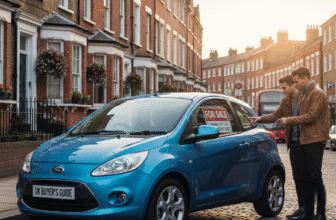
The Ultimate UK Buyer’s Guide: Finding the Perfect Kia Picanto for Sale
In the bustling towns and crowded city streets of the United Kingdom, the hunt for the perfect city car is a serious quest. You need something small enough to nip into tight parking spaces, economical enough to not break the bank on the daily commute, and stylish enough to hold its own. For years, one name has consistently popped up as a front-runner, a true champion of the urban jungle: the Kia Picanto. More than just a budget runaround, the Picanto has evolved into a genuinely desirable, tech-savvy, and remarkably practical small car. If you’re currently scrolling through listings for a “Kia Picanto for sale,” you’ve come to the right place. This is your comprehensive guide to navigating the market, understanding the different models, and ultimately, driving away in the perfect Picanto for you.
Why Has the UK Fallen for the Picanto?
Before we dive into the nuts and bolts of buying one, it’s worth understanding why the Picanto has become such a staple on British roads. Its appeal is multi-faceted. For first-time drivers, its low insurance groups and easy-to-drive nature are a massive draw. For city dwellers, its compact dimensions and excellent fuel economy make it a logical choice. For those seeking a reliable and affordable second car for school runs or local errands, it ticks every box. However, the Picanto’s secret weapon, and a huge reason for its success, has always been Kia’s industry-leading 7-year warranty. This transferable warranty means that even a three or four-year-old used model can offer the same peace of mind as a brand-new car, a proposition that is almost unheard of in the used car market.
A Journey Through the Picanto Generations

Finding the right Picanto means understanding its evolution. Each generation brought significant improvements in style, safety, and technology. Knowing the differences will help you pinpoint the model that best suits your budget and needs.
First Generation (2004-2011): The Plucky Original
The car that started it all. The first-generation Picanto was a simple, honest, and incredibly affordable city car. Its design was cheerful and unassuming, and it quickly gained a reputation for being a dependable and cheap-to-run machine. If you’re on a very tight budget, this is where you’ll be looking.
- What to Expect: Inside, it’s a no-frills affair. Plastics are hard and the equipment list is basic, especially on entry-level models which might not even have central locking. However, its simplicity is also its strength – there’s less to go wrong.
- Engines: You’ll primarily find 1.0-litre and 1.1-litre four-cylinder petrol engines. Neither is powerful, but they are perfectly adequate for city driving and are known for their reliability.
- What to Check: At this age, rust is the main enemy. Check the wheel arches, sills, and underbody thoroughly. Clutches can be worn from years of city driving, so ensure the biting point feels right. Also, check that all basic electrics, like the windows and heater fan, work as they should.
- Value Proposition: This is bargain-basement motoring. For very little money, you get a reliable runabout that’s incredibly cheap to insure and tax.
Second Generation (2011-2017): A Revolution in Style and Substance
This is where the Picanto truly came of age. Under the guidance of famed designer Peter Schreyer (the man behind the original Audi TT), the second-generation Picanto was transformed. It sported a far more aggressive and stylish look, featuring the now-iconic ‘tiger-nose’ grille. It wasn’t just a pretty face; the interior quality, ride comfort, and available technology took a giant leap forward.
- What to Expect: A much more modern and pleasant cabin. The dashboard layout is smarter, the materials feel better, and you start to see features like Bluetooth connectivity, steering wheel controls, and air conditioning as standard on mid-range models. For the first time, a sportier-looking 3-door version was offered alongside the practical 5-door.
- Engines: This generation introduced Kia’s more modern and efficient ‘Kappa’ engine family, primarily in 1.0-litre (three-cylinder) and 1.25-litre (four-cylinder) guises. The 1.25-litre is the one to go for if you plan on occasional motorway journeys, offering a bit more flexibility.
- What to Check: These cars are generally very robust. Check for a full service history to ensure any warranty work has been done. The brakes, particularly the rear discs on higher-spec models, can wear, so listen for any grinding noises. Test the infotainment system to make sure everything connects and works correctly.
- Value Proposition: This generation represents the sweet spot in the used market. It feels significantly more modern than the first-gen car but costs a fraction of the latest model. You can find a well-maintained example with a decent spec and potentially some of that 7-year warranty remaining.
Third Generation (2017-Present): The Complete City Car
The current Picanto is a masterpiece of small-car packaging. It built on the success of its predecessor with an even sharper design, a class-leading interior, and a level of technology you’d expect to find in a much larger vehicle. It’s more spacious, more comfortable, and safer than ever before.
- What to Expect: A genuinely premium-feeling cabin for a city car. The highlight is the ‘floating’ touchscreen infotainment system found on most trims, which includes Apple CarPlay and Android Auto. This generation also saw the introduction of distinct personalities within the range, like the sporty ‘GT-Line’ with its aggressive body kit and the SUV-inspired ‘X-Line’ with its raised ride height and rugged cladding.
- Engines: The excellent 1.0-litre and 1.25-litre naturally aspirated engines were carried over and refined. The big news was the introduction of a punchy 1.0-litre T-GDi turbocharged engine, offering 99bhp. This turns the Picanto into a proper little warm hatch, providing genuinely fun performance without sacrificing too much economy. A facelift in late 2020 streamlined the engine range and updated the styling and tech.
- What to Check: These are modern, reliable cars. The single most important thing is a full Kia service history. Without it, the 7-year warranty is void. Check the diamond-cut alloy wheels on high-spec models for kerb damage, as they are expensive to repair. Ensure the advanced driver aids (like Autonomous Emergency Braking on newer models) are functioning correctly.
- Value Proposition: As the latest model, this is the most expensive, but you get what you pay for. It’s one of the best city cars on the market, full stop. A two or three-year-old example offers fantastic value, giving you a nearly-new car with a huge chunk of warranty left for a significant saving over the list price.
Cracking the Code: Understanding UK Trim Levels
Kia’s trim structure is generally logical, ascending numerically. While the specifics can vary slightly by model year, here’s a general guide to what you can expect:
- ‘1’: The entry-level model. It’s quite basic and often lacks features like air conditioning or alloy wheels. Best for those on the strictest budget.
- ‘2’: Often the best value. This trim typically adds the essentials that most buyers want, such as air-con, alloy wheels, electric windows all-round, and Bluetooth connectivity.
- ‘3’: The high-spec choice. This is where you’ll find the larger touchscreen infotainment system, cruise control, climate control, and often parking sensors.
- ‘GT-Line’ & ‘GT-Line S’: These are the sporty models. They get unique bumpers, side skirts, larger alloys, and often a more premium interior with red accents. The ‘S’ model usually adds every possible bell and whistle, like heated seats and a wireless phone charger.
- ‘X-Line’ & ‘X-Line S’: These feature the SUV-inspired look with rugged body cladding, a slightly raised suspension, and unique styling details. A great choice if you want your city car to stand out.
Your Pre-Purchase Inspection Checklist
Found a Picanto you like? Brilliant. Now it’s time to give it a thorough check-over. As a car that spends most of its life in the city, it can be prone to certain types of wear and tear.
The Walkaround
- Bodywork: Look for car park dings in the doors and scuffs on the corners of the bumpers. Check panel gaps are even.
- Wheels and Tyres: City driving means kerbed alloys are common. Check the condition of all four. Ensure all tyres are from a reputable brand and have plenty of tread. Uneven tyre wear could indicate an alignment issue.
The Interior
- Seats and Trim: Check the driver’s seat bolster for wear from getting in and out. Make sure all seat adjustments work.
- Electrics: This is crucial. Test everything. Windows, mirrors, air-con (does it blow cold?), stereo, infotainment screen, USB ports, and all lights.
The Paperwork
- V5C Logbook: Check that the chassis number (VIN) and engine number on the document match the car. Ensure the seller’s name and address are on the V5C.
- Service History: For any Picanto from 2011 onwards, a full service history (ideally from Kia) is non-negotiable if you want to benefit from the remainder of the warranty. Check the stamps and invoices.
- MOT History: You can check a car’s MOT history for free on the GOV.UK website. Look for recurring advisories, which could point to future expenses.
The Test Drive
- The Clutch: Does the clutch feel heavy or does it bite very high up the pedal’s travel? This could mean it’s on its way out.
- The Gearbox: Changes should be smooth and easy. Any crunching or difficulty selecting a gear is a red flag.
- Brakes and Suspension: Listen for any knocking or clonking sounds when going over bumps. Does the car pull to one side when you brake?
Running Costs: The Picanto’s Ace Card
A key reason for buying a Picanto is its incredibly low running costs. Insurance groups are among the lowest in the market, making it perfect for new drivers. Vehicle Excise Duty (road tax) is also very cheap; many pre-April 2017 models fall into the £0 or £20-a-year bracket. Even post-2017 models are charged at the standard (and relatively low) rate. Fuel economy is a standout feature, with most models easily capable of achieving over 50 MPG in real-world driving conditions.
Conclusion: Your Perfect City Companion Awaits
The Kia Picanto is more than just a sensible choice; it’s a clever one. It proves that you don’t need to sacrifice style, technology, or peace of mind to get an affordable and economical car. From the budget-friendly first generation to the sophisticated and tech-laden current model, there is a Picanto out there to suit every taste and budget. Armed with this knowledge, you can approach the market with confidence. Take your time, do your checks, and get ready to enjoy one of the most capable and charming city cars the UK has to offer.







